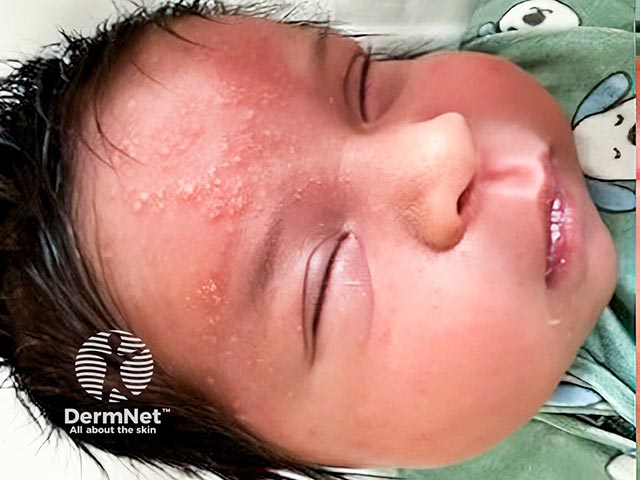Main menu
Common skin conditions

NEWS
Join DermNet PRO
Read more
Quick links
Last Reviewed: March, 2025
Author(s): Dr Stanley Leong, Dermatology and Paediatric Registrar, Department of Dermatology, Christchurch Hospital, New Zealand (2025).
Peer-reviewed and edited by: Dr Laura Wallace, Hutt Valley Hospital, New Zealand (2025)
Reviewing dermatologist: Dr Ian Coulson
Edited by the DermNet content department
Introduction
Demographics
Causes
Clinical features
Diagnosis
Differential diagnoses
Treatment
Outcome
Eosinophilic pustular folliculitis of infancy (EPFI) is a rare, pruritic, benign skin disease that mainly affects children younger than 36 months old. It is a sterile inflammatory disease characterised by recurrent outbreaks of isolated or grouped non-infective pustules that contain eosinophils, along with peripheral blood eosinophilia. It is usually localised on the scalp but can involve other body sites such as the face, neck, trunk, and extremities.
EPFI was first reported in 1984 and it is the least well-characterised of the eosinophilic pustular folliculitis (EPF) diseases. The main variants are:
EPFI typically lacks the annular or polycyclic ring characteristic of adult EPF and has a preference for the scalp.

Sterile pustules on the face of a newborn; Tzanck smear of the pus showed numerous eosinophils confirming EPFI.
EPFI often presents in the first 14 months of life and usually resolves by 3 years of age. It has an early age of onset; only 5% of patients with EPFI presented for the first time after 14 months of age, while up to 70% developed the disease before 6 months of age.
EPFI is four times more common in males than females. Reports suggest that it may run in families, particularly among brothers.
The underlying pathophysiology of EPFI remains unclear, however, it is speculated that immune dysregulation plays a role.
EPFI presents with recurrent episodes of aseptic papulo-pustules on an erythematous base.
The scalp is the most common site of involvement, with up to two-thirds of patients also having widespread lesions on the face, neck, trunk, and extremities. Patients are systemically well, but there may be an association with atopy.
The papulopustular lesions can be isolated or clustered, often with secondary crusting. They heal over a period of 1-4 weeks and may leave areas of localised hyperpigmentation. Recurrences may occur at these sites.
Pruritus and eosinophilia are present in the vast majority of patients. Eosinophilia is usually only elevated during active skin flares.
Recognising the condition and distinguishing it from other types of pustular lesions is critical to avoid unnecessary diagnostic procedures and inappropriate treatments, especially in vulnerable populations such as preterm infants. The diagnosis should be considered in newborns or infants presenting with a papulopustular eruption.
EPFI is diagnosed based on both the clinical time course and histopathological findings. Scalp involvement, tissue eosinophilia and recurrent outbreaks are considered cardinal manifestations of EPFI.
In the majority of cases, blood tests will show an eosinophilia, however, this is only present during the outbreak’s acute phase. Cultures must be done in order to exclude infectious etiologies.
A Tzanck smear often shows an abundance of eosinophils and may be preferable than undertaking a biopsy.
A skin biopsy of EPFI shows non-specific histologic changes. These include:
Histology in EPFI does not show true folliculitis in most cases, whereas in classical eosinophilic pustular folliculitis pathology, this is an essential part of the diagnosis.
EPFI has no established treatment guidelines. However, 90% of cases have responded well to a mild or moderate potency topical corticosteroid. Antibiotics are ineffective in treating EPFI itself, but appropriate if a secondary infection of the lesions occurs.
Other treatments include topical tacrolimus and oral antihistamines. In refractory cases, dapsone, erythromycin, and indomethacin have been proposed.
EPFI is a rare but benign and self-limiting skin disorder. The condition does not require aggressive treatment and usually resolves spontaneously by the time the child is three years old.